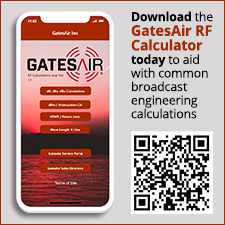.gif)
MEDIA CENTER
News
GatesAir To Demonstrate 5G Passthrough to Mobile Devices at IBC2024
GatesAir adds modulation techniques to Maxiva transmitters to push 5G signals direct to mobile over UHF channels
Cincinnati, OH, September 12, 2024
GatesAir, a subsidiary of Thomson Broadcast dedicated to wireless content delivery, will take its wireless spectrum expertise into new territory at IBC2024 with a live demo that shows 5G passthrough of live TV content to mobile devices. GatesAir will employ 5G modulation within its Maxiva XTE exciter to send live video content to a smartphone across the 5G waveform. The new modulation technique will effectively extend the delivery range of GatesAir’s Maxiva ULXTE, UAXTE and OP Series of liquid-cooled and air-cooled UHF transmitters to mobile audiences.
Fulfilling a growing need for 5G broadcast support across Europe and Asia, GatesAir’s provision of 5G delivery across the UHF channels not only guarantees 5G exclusivity for voice and mobile cellular use, but also gives broadcasters the ability to adopt 5G delivery without needing to replace their existing transmitters.
“Although most broadcast transmitters are built for terrestrial digital waveforms such as ATSC 3.0 and DVB-T/T2, there is a growing requirement for broadcasters across Europe and Asia to support 5G waveforms for content distribution,” said Keyur Parikh, Vice President of Engineering, GatesAir. “Our Maxiva transmission products are built for standards-agnostic transmission. With broadcasters eyeing the potential impact of 5G for terrestrial TV, GatesAir is prepared to help our customers make the most of their UHF spectrum for wireless content delivery.”
With traditional 5G frequencies reserved as a high price commodity for voice and mobile cellular, broadcasters are already assessing the possibility of offloading broadcast content to a UHF frequency. Adopting the UHF frequency allows broadcasters to avoid using valuable mobile spectrum, and it also means that consumers can receive, decode and view content on the same mobile devices that they already use.
“The ability to deliver broadcast content to a phone without congesting the mobile frequencies that are reserved for voice and mobile data gives our customers more options,” added Parikh. “It gives them the ability to deliver exclusive content across 5G channels, or simply deliver the same content to more devices. Crucially, it allows them to do so whenever the broadcast infrastructure is upgraded without having to invest in new transmission equipment.”
GatesAir representatives will be available to discuss 5G as well as more traditional terrestrial waveforms on Stand 8.C74 at IBC2024.










